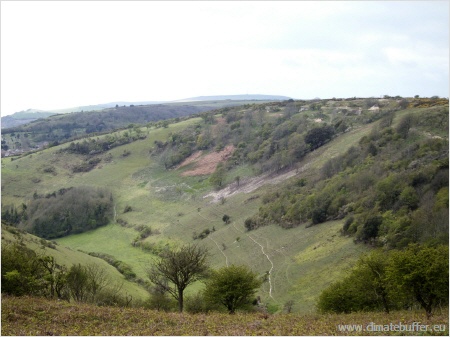Ventnor Downs
General Description
The Ventnor downs are on the southern coast of the Isle of Wight and are the most southerly chalk outcrop in Britain. Originally a small fishing village, Ventnor was popularised by Victorian poets and artists, and it became a fashionable seaside resort and a desirable place to build a villa to enjoy the favourable coastal climate.
Ventnor replicated the Mediterranean idyll and many of the plants chosen for the villa gardens were of Mediterranean origin. One tree species, the holm or evergreen oak, particularly thrived in the favourable climate and lime rich soils to such an extent that it rapidly spread onto the surrounding downland getting a strong foothold on the steep ungrazed parts of the chalky slopes.

Ventnor
(Photo: Marthe Olthof, Natuurmonumenten)
Holm oak: from problem to solution
By the late 1980s, the Holm Oak was threatening to take over the best of the species-rich chalk grassland. Although cattle reintroduced to graze the grassland do eat holm oak, they have failed to halt the colonisation by new seedlings which thrive in the chalky soils and favourable maritime climate. Regrowth of cut stumps was also a problem despite the use of herbicide.
The solution came about after seeing a documentary on a wood pasture system in the Spanish region of Extremadura which showed how goats had originally shaped those particular landscapes. Inspired by this, and after local Trust staff researched the feasibility, they introduced a breeding herd of feral goats to an area of the Ventnor downs. They had the immediate effect of controlling all regrowth and seedlings. After a period of thirteen years, the presence of the goats has brought holm oak colonisation to a controllable level with only mature trees free from the effect of goat damage.
The National Trust is now going to deal with the mature trees in a different way. In the past, they have clear felled large areas of mature trees which has led to large bare areas that have been slow to re-colonise with chalk grassland but quick to be colonised by weeds. As a result, they are planning to develop a wood pasture system by thinning mature trees. This will allow light onto the ground where chalk flora (and in some cases heathland) will develop. This will be sustained by cattle grazing (or other grazing animals) and the goats will continue to control the growth of woody species by browsing. The whole system will be dynamic.
The project started in 2010 and was finished in 2012.